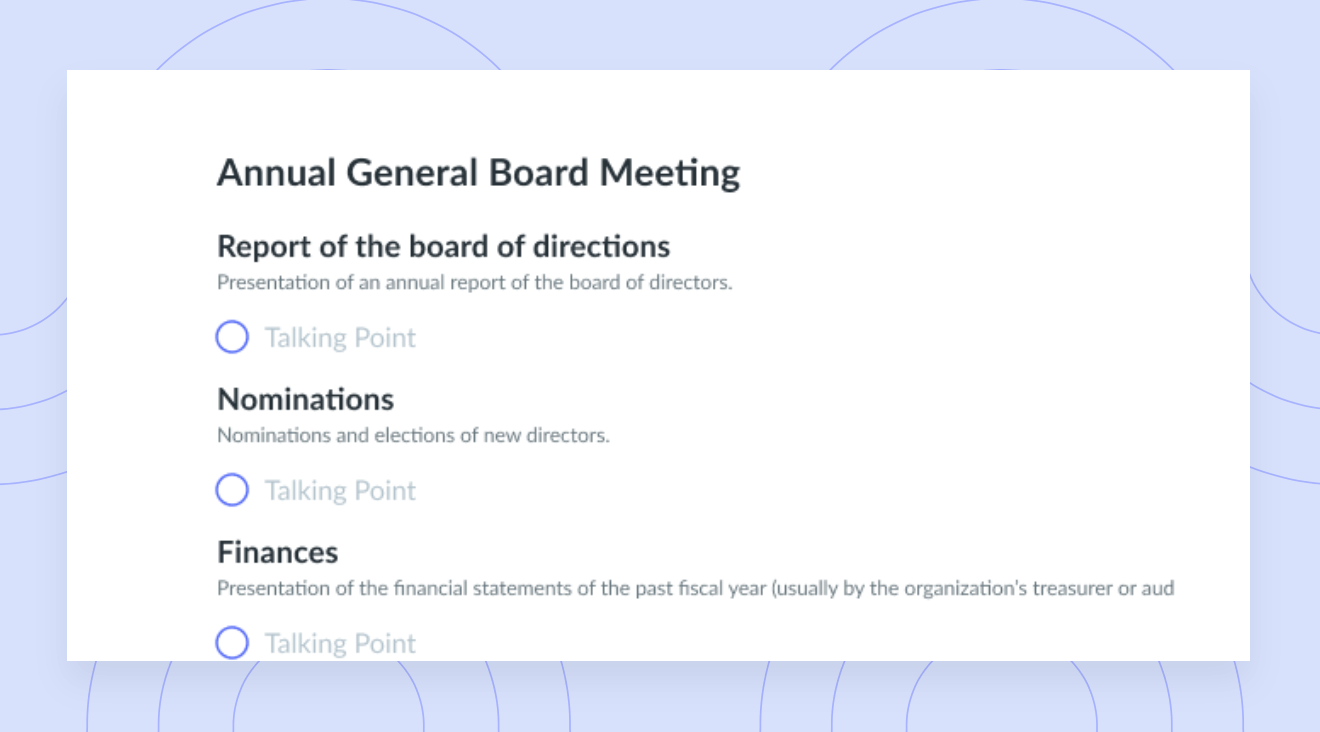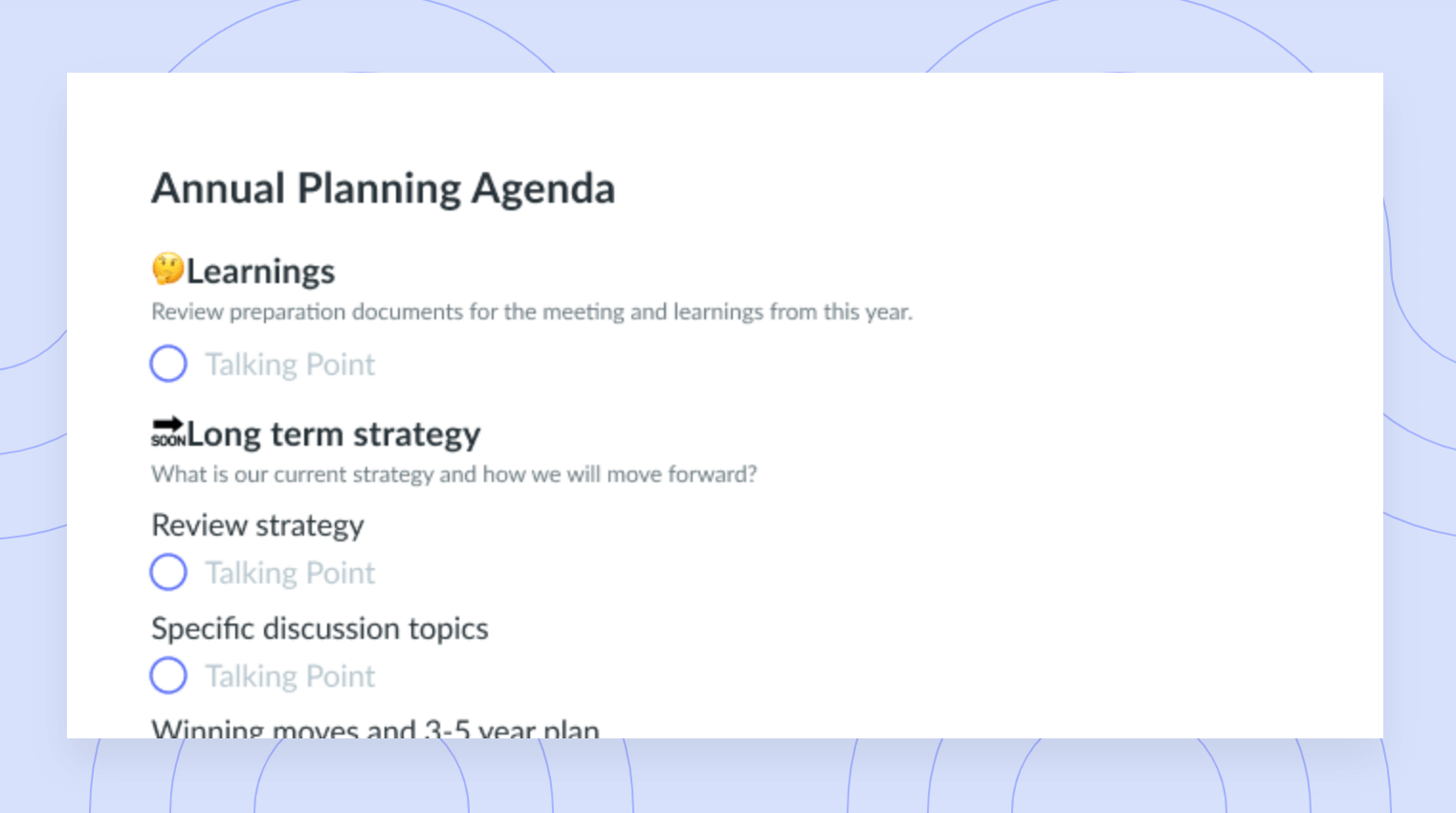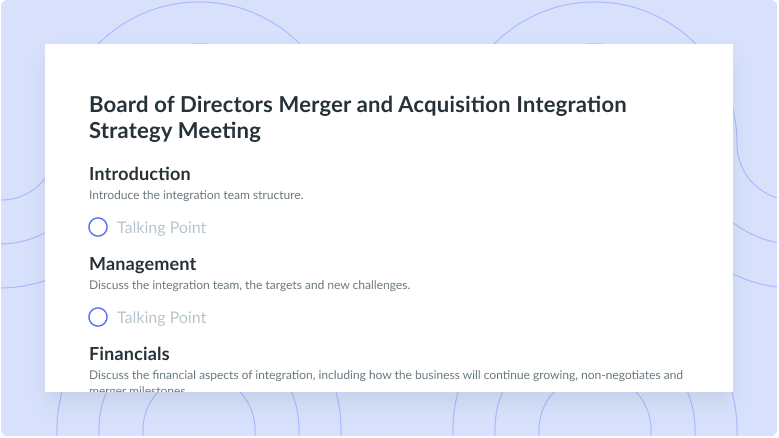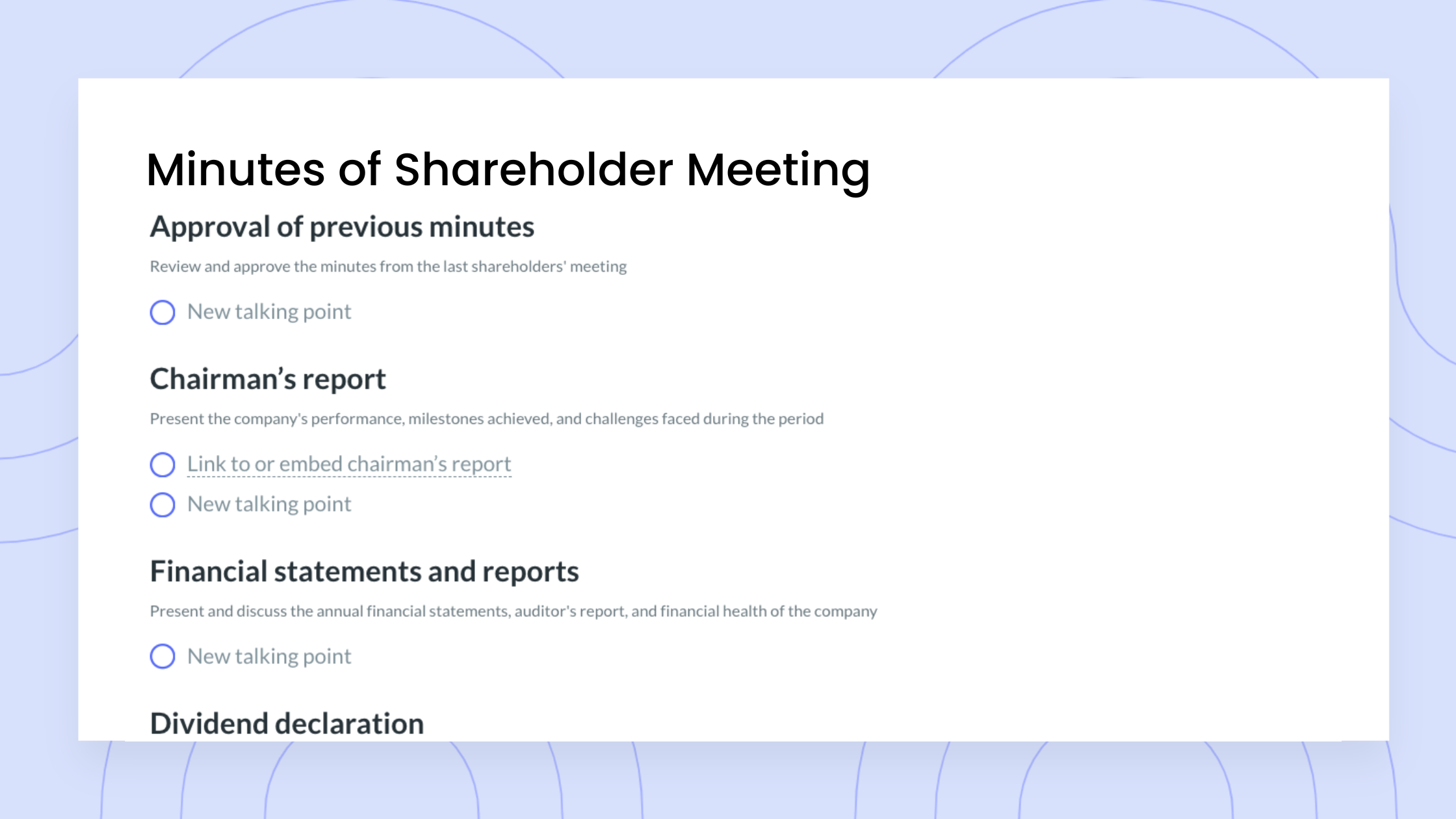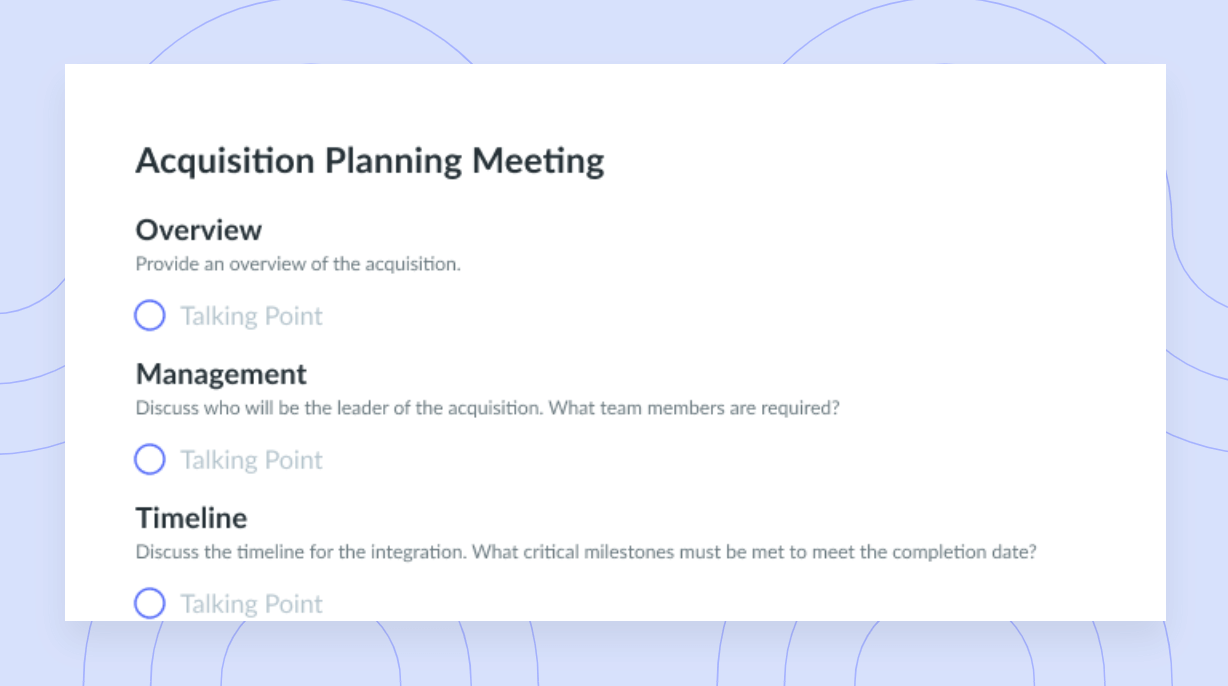How to Run a Delightful AGM [+ Free Template]
Make event planning stress-free by learning how to run a AGM and how to use an AGM agenda that sets your team up for success!
It’s that time of year again! All of your company’s senior executives and board members are preparing for the organization’s annual general meeting (AGM). You’ve always watched the event come together from afar, but as part of your role, you’re helping plan this year’s affair. While you’re excited to participate, the details are overwhelming. You want to make sure that the meeting goes off without a hitch and that attendees leave the meeting feeling informed and delighted.
Let’s discuss what an AGM is, how to run a successful one, and what you should include in your own company’s AGM agenda.
- What is an AGM?
- Who attends an AGM?
- How to run an AGM
- What to include in your AGM agenda
- Free AGM agenda template
What is an AGM?
An AGM is a yearly affair held to discuss a variety of topics, including finances, board elections, and other matters that affect the company. During this time, directors of the organization present an annual report that contains information regarding the company’s performance and strategy to stakeholders. Additionally, shareholders and other individuals with voting rights vote on both company issues and the selection of the company’s board of directors. These meetings are important as they provide transparency and hold management accountable.

Run delightful AGM meetings
Increase meeting engagement and productivity with a collaborative agenda that the whole team can contribute to. Try using a tool like Fellow!

Who attends an AGM?
The shareholders of a company and the board of directors are usually in attendance at every AGM. This is likely the only time these two parties will meet throughout the year, so it’s important that the time is used wisely. During the meeting, shareholders can voice their concerns and opinions about the organization’s conduct and protect their own interests by participating in major decision-making. Shareholders usually elect the board of directors—the highest positions in the company—including the chief executive officer (CEO) and chief financial officer (CFO) at this time.
How to run an AGM
- Appoint meeting roles
- Create and share a meeting agenda
- Send a meeting reminder
- Share necessary documents
- Take meeting minutes
- Send a meeting follow-up email
1Appoint meeting roles
During the planning for your company’s AGM, meeting roles need to be assigned. Someone needs to be in charge of organizing the event, and someone needs to host the meeting and keep things on track. There also needs to be one or more individuals assigned to note taking and time-keeping. Before the meeting, attendees should receive a brief agenda that outlines what their roles will be during the AGM. Make sure that you provide training to members with new roles so the event runs smoothly for all.
2Create and share a meeting agenda
How will anyone know the goal or purpose of the AGM if there isn’t a meeting agenda? If you want your event to run smoothly and stay within the timeframe you’ve allotted, distribute an agenda in advance. Empower everyone to be informed by following up your meeting invitation with an agenda. The agenda should be sent out at least a few days before your AGM so shareholders have time to prepare their questions and concerns, and so the board and executives in your company know exactly when they’ll be required to speak.

3Send a meeting reminder
Ensure that attendance is great by sending a meeting reminder before the event. Use Fellow’s pre-event reminders to automatically notify attendees to review the meeting agenda. Using this feature, reminders may be sent via Slack, Microsoft Teams, or email. Use the platform that will reach all attendees. Have a designated contact-person to whom shareholders or other meeting-goers may reach out with questions or comments in advance of the event!
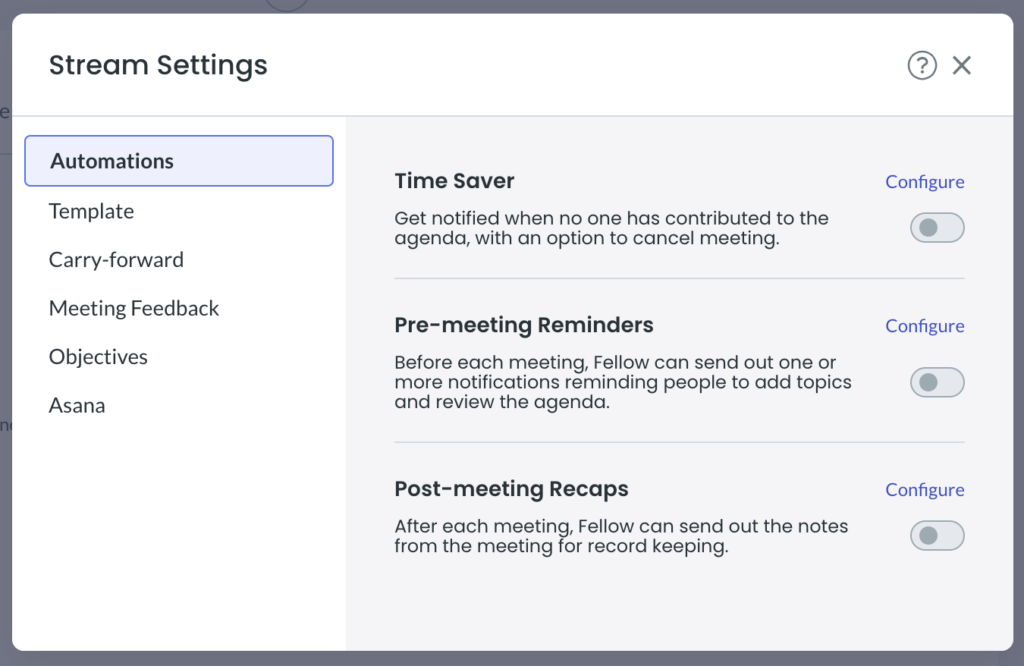
4Share necessary documents
Before the meeting, a handful of important documents need to be prepared and distributed to the attendees. Budgets and financial statements need to be ready in advance so shareholders can make informed decisions, especially if they’re required to vote on issues during the AGM. Other documents that may need to be distributed include previous AGM minutes, and the president’s, treasurer’s, and secretary’s reports. Remind any participating committee members to take care of their documents so they can be distributed as early as possible.
5Take meeting minutes
Meeting minutes should record any decisions made during the AGM, especially those that involve elections or changes to the organization’s structure or constitution. Meeting minutes are usually taken by the board’s secretary or someone else appointed by the meeting organizer. Be sure to record the names and contact information of the attendees, too—you can do so easily by having each person sign in as they arrive on the day of the AGM.
6Send a meeting follow-up email
After the AGM, send a follow-up email to all attendees that summarizes the meeting, outlines any decisions that were made, and of course, thanks everyone for attending! Attach meeting minutes and any reports that were approved by the membership to the email. Make sure your communications are concise, but thorough. The follow-up email can include a nice message from the board president, CEO, or chairperson that expresses gratitude to all attendees and shareholders.
What to include in your AGM agenda
- Report of the board of directors
- Nominations
- Finances
- Appointment of auditor
- Amendments, changes, or additions
1Report of the board of directors
At the start of the meeting, make any necessary apologies if a significant member of the group is absent. Then, verify that everyone has received a copy of last year’s meeting minutes and review them as a group before formally accepting them. The board of directors can now begin to deliver their reports and seek approval of the membership. The reports may include: a president’s and chairman’s report; the secretary’s and CEO’s report; board member reports or changes; staff updates or changes; a summary of any progress made to the strategic plan; thanks and acknowledgement of sponsors, supporters, and attendees; and anything else that is relevant to your organization.
2Nominations
Once the reports have been delivered, go through any elections. Before the AGM, any vacant positions and names of nominees should be presented to shareholders and other attendees. Any board members seeking re-election need to be a part of this communication. Voting can be done by voice, ballot, roll call, or a number of other methods. There should always be a neutral party present to count the votes. It’s common practice for the chair of the board to meet with new board members immediately after the meeting to welcome the group and set a date for an orientation meeting.
3Finances
The company’s finances may be discussed during the report by the board of directors, or at another time during the meeting. This task is usually performed by the board’s treasurer, but is sometimes conducted by an independent party. AGMs usually take place within five months of the end of the financial year so the reports are still timely and relevant.
4Appointment of auditor
During each AGM, an independent firm of accountants is selected to conduct an audit of the company’s accounts. Appointments of auditors are typically renewed on an annual basis. The annual audit is signed off by the board of directors before presentation at the meeting. The process may seem unusual, but confirming the auditing firm for the following year ensures that everything will run smoothly as changes are made.
5Amendments, changes, or additions
Each year, clauses in a company’s constitution may need tweaking. Other years may involve a complete overhaul. These changes usually take place at the AGM and require much negotiation from the board of directors. Before the meeting, members of the board or independent consultants should work to draft necessary changes to the constitution. During the actual meeting, one motion that incorporates all changes is presented to the group of attendees for approval. This may seem like a confusing process, but it ensures that everyone is consulted in the lead up to the AGM so nothing out of the blue comes up during the meeting.
Free AGM agenda template
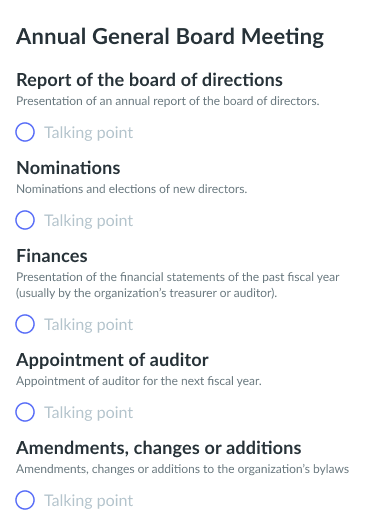
Parting advice
Picture this: you’ve been asked by your manager to help out at your company’s next AGM. What an honour! You’re nervous about getting it right, so you connect with your teammates, take a look at last year’s meeting notes, and follow our meeting agenda tips to begin the process. Before you know it, you’ve successfully planned your first AGM!
While there isn’t one “right” formula, you should plan for an AGM to be as engaging and informative as possible. Remember, this is a time for important business to be discussed, but it’s also a great opportunity for shareholders to get to know the company’s leaders and vote on matters that will make the organization more successful in the long run. Whether you’re organizing an AGM, taking part in one, or learning the ins and outs for the first time, follow these tips and tricks and you’ll be one step closer to conducting an effective AGM that represents your company’s mission and values.

![Quarterly Planning: Ultimate Guide for 2024 [+Free Template]](https://fellow.app/wp-content/uploads/2023/03/GUIDETO-QUARTERLY-PLANNING2.jpg)
![Formal vs. Informal Meetings: What Are the Key Differences? [+ FREE Templates]](https://fellow.app/wp-content/uploads/2022/05/Formal-vs.-Informal-Meetings-2.jpg)
![11 Of The Best Digital Daily Planner Tools [+ FREE Template]](https://fellow.app/wp-content/uploads/2022/06/Best-digital-daily-planner-tools.jpg)






